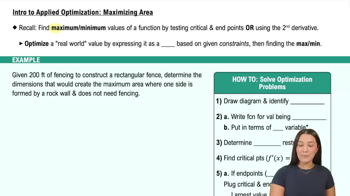Derivative of y = |x| Graph the derivative of f(x) = |x|. Then graph y = (|x| − 0)/(x − 0) = |x|/x. What can you conclude?
Table of contents
- 0. Functions7h 54m
- Introduction to Functions16m
- Piecewise Functions10m
- Properties of Functions9m
- Common Functions1h 8m
- Transformations5m
- Combining Functions27m
- Exponent rules32m
- Exponential Functions28m
- Logarithmic Functions24m
- Properties of Logarithms36m
- Exponential & Logarithmic Equations35m
- Introduction to Trigonometric Functions38m
- Graphs of Trigonometric Functions44m
- Trigonometric Identities47m
- Inverse Trigonometric Functions48m
- 1. Limits and Continuity2h 2m
- 2. Intro to Derivatives1h 33m
- 3. Techniques of Differentiation3h 18m
- 4. Applications of Derivatives2h 38m
- 5. Graphical Applications of Derivatives6h 2m
- 6. Derivatives of Inverse, Exponential, & Logarithmic Functions2h 37m
- 7. Antiderivatives & Indefinite Integrals1h 26m
- 8. Definite Integrals4h 44m
- 9. Graphical Applications of Integrals2h 27m
- 10. Physics Applications of Integrals 3h 16m
- 11. Integrals of Inverse, Exponential, & Logarithmic Functions2h 31m
- 12. Techniques of Integration7h 41m
- 13. Intro to Differential Equations2h 55m
- 14. Sequences & Series5h 36m
- 15. Power Series2h 19m
- 16. Parametric Equations & Polar Coordinates7h 58m
2. Intro to Derivatives
Derivatives as Functions
Problem 3.3.66
Textbook Question
The best quantity to order One of the formulas for inventory management says that the average weekly cost of ordering, paying for, and holding merchandise is
A(q) = (km / q) + cm + (hq / 2),
where q is the quantity you order when things run low (shoes, TVs, brooms, or whatever the item might be); k is the cost of placing an order (the same, no matter how often you order); c is the cost of one item (a constant); m is the number of items sold each week (a constant); and h is the weekly holding cost per item (a constant that takes into account things such as space, utilities, insurance, and security).
Find dA/dq and d²A/dq².
 Verified step by step guidance
Verified step by step guidance1
Identify the function A(q) given in the problem: A(q) = (km / q) + cm + (hq / 2). This is the function for which we need to find the first and second derivatives with respect to q.
To find the first derivative, dA/dq, apply the power rule and the constant rule. The term (km / q) can be rewritten as km * q^(-1). The derivative of cm with respect to q is 0 since it is a constant. The derivative of (hq / 2) is h/2 since it is a linear term in q.
Calculate the derivative of the first term: d/dq [km * q^(-1)] = -km * q^(-2).
Combine the derivatives to find dA/dq: dA/dq = -km * q^(-2) + 0 + h/2.
To find the second derivative, d²A/dq², differentiate dA/dq with respect to q. The derivative of -km * q^(-2) is 2km * q^(-3), and the derivative of h/2 is 0 since it is a constant. Thus, d²A/dq² = 2km * q^(-3).
 Verified video answer for a similar problem:
Verified video answer for a similar problem:This video solution was recommended by our tutors as helpful for the problem above
Video duration:
3mPlay a video:
Was this helpful?
Key Concepts
Here are the essential concepts you must grasp in order to answer the question correctly.
Derivative
The derivative of a function measures how the function's output value changes as its input changes. In this context, finding dA/dq involves applying differentiation rules to determine how the average weekly cost A(q) changes with respect to the order quantity q. This helps in understanding the rate of change of cost with varying order sizes.
Recommended video:

Derivatives
Second Derivative
The second derivative, denoted as d²A/dq², provides information about the curvature or concavity of the function A(q). It indicates whether the function is concave up or down, which is crucial for identifying local minima or maxima. In inventory management, this helps determine the optimal order quantity that minimizes costs.
Recommended video:

The Second Derivative Test: Finding Local Extrema
Optimization
Optimization involves finding the best solution from a set of possible choices. In this problem, it refers to determining the order quantity q that minimizes the average weekly cost A(q). By analyzing the first and second derivatives, one can identify critical points and assess their nature to find the optimal order size that balances ordering and holding costs.
Recommended video:

Intro to Applied Optimization: Maximizing Area
Related Videos
Related Practice
Textbook Question


